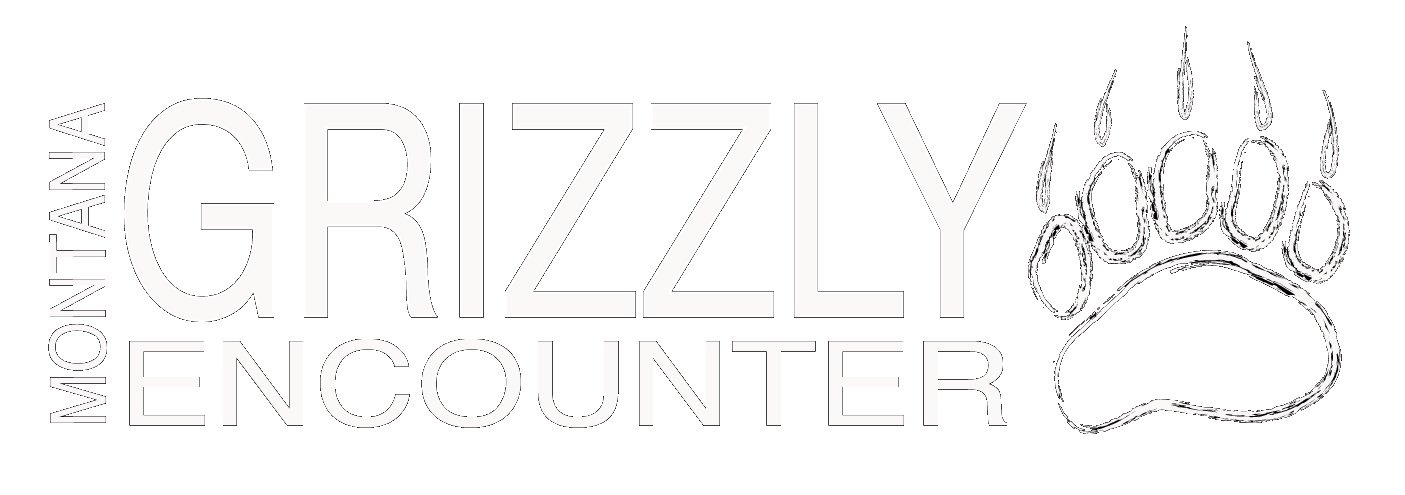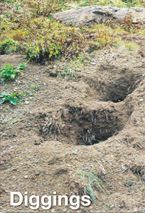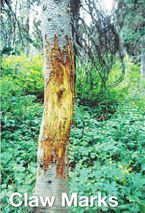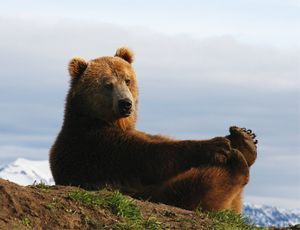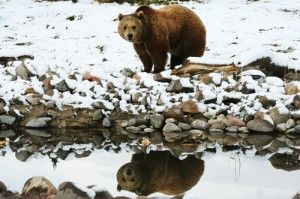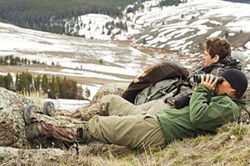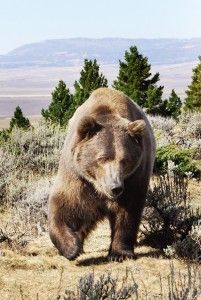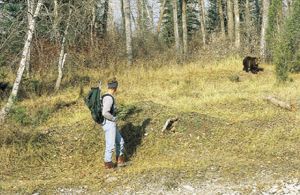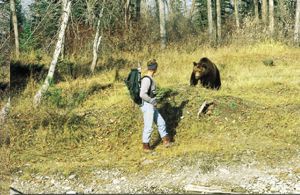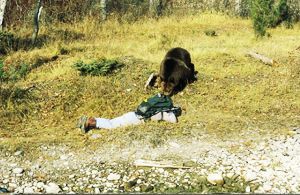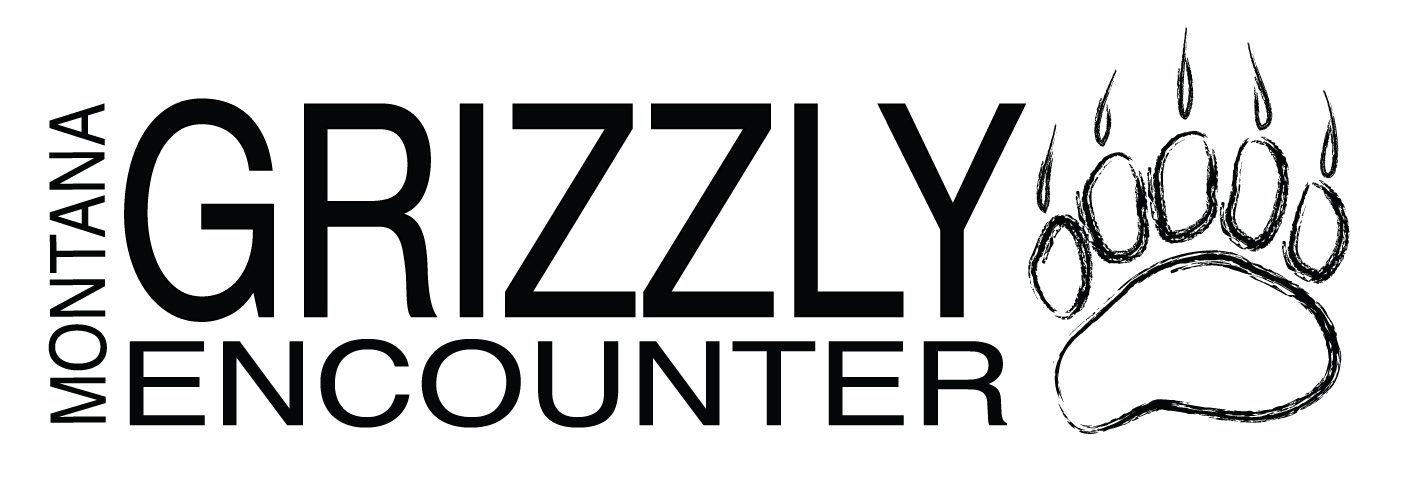Bear Education
Bear Habitat Guidelines for Outdoor Enthusiasts
The Northwest is home to both the black bear and the grizzly bear. As recreationists and bear populations increase, bears and people have to share the same areas. To coexist, we must minimize our impacts on bears and the habitat on which they depend. Please visit bear country with respect, courtesy and caution.
Common causes of attacks:
- Not making sufficient noise.
- Approaching or surprising a bear, especially at close range.
- Startling a female with cubs.
- Getting close to a carcass or other food source.
- Hiking off-trail or at night.
- Running when a bear is nearby.
Bear country can also be home to other wildlife that can be dangerous as well. Always maintain a safe and respectful distance from wildlife.
Essential Bear Safety Tips
Ensure your safety and the well-being of bears while exploring their habitat by following these essential precautions:
- Be alert: Watch for bear signs such as tracks, droppings, diggings, rocks rolled over, scratch marks on trees and logs torn apart. Carry binoculars and scan ahead periodically.
- Let someone know where you are going and when you plan to return.
- Keep children close to you and within your immediate sight.
- Stay on the trail for your safety and to protect the habitat.
- Don’t Hike Alone or at Night: Bears are most active at dawn, dusk and at night, but can be encountered at any time.
- Groups of three or more people make more noise and appear more formidable.
- Make noise: talk or sing to let a bear know your presence. This is most effective because bears have a fear of humans and talking is an easy way to distinguish yourself as such. Don’t rely on bells; they do not sound like a human. Speak loudly when traveling upwind, near streams and waterfalls, or when you cannot see the path ahead. Avoid a thick brush.
- Avoid Carcasses: Report dead animals near a trail or campsite to the nearest ranger station. It is very risky to approach a carcass; a bear may be just out of sight, guarding its food.
Bears of North America
Dive into the fascinating world of North American bears, exploring the unique characteristics and habitats of the Black Bear, Brown Bear, and Polar Bear.
Black Bear (Ursus americanus)
- Habitat is most common in North America.
- Colors include black, brown, blond, cinnamon, and rust.
- The average weight is 100–350 pounds. In some places, up to 700 pounds
- Height is 3 feet at shoulders, 6 feet standing.
- The rump is higher than the front shoulders.
- The face profile is straight; the muzzle is relatively long.
- Ears are long and prominent.
- The front claws are less than 2 inches long, curved, and good for climbing. Claw marks do not always show up in tracks.
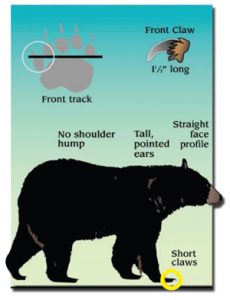
Brown Bear (Ursus arctos - Grizzly and Kodiak bears)
- Habitat is in the Northwestern States, Alaska and Western Canada.
- The color varies from blond to black. Often “grizzled” blond on the ends.
- Average weight varies: Interior bears weigh 300–500 pounds. Coastal bears weigh 800-1200 pounds.
- Height: Interior bears 4 feet at shoulder, 7 feet standing. Coastal bears are 5.5 feet at shoulder, 8–11 feet standing.
- Ears are round and proportionately small.
- The distinctive shoulder hump is mostly muscle.
- A dished-in profile between eyes and end of snout.
- The front claws are 2-4 inches long. Claw marks are usually visible on tracks.
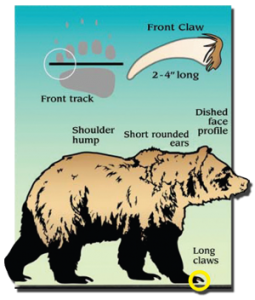
Polar Bear (Ursus maritimus)
- Habitat is Arctic and Sub-Arctic.
- The color varies from bright white to a yellowish or gray tint.
- The average weight is 775–1,500 pounds.
- Height is 5.5 feet at the shoulder and 8–11 feet when standing.
- Ears are round and proportionally small.
- The distinctive shoulder hump is mostly muscle mass that enables powerful swimming.
- The face profile is straight; the muzzle and neck are relatively long.
- Front claws are 2-3 inches long, curved, and good for hunting seals and climbing on ice.
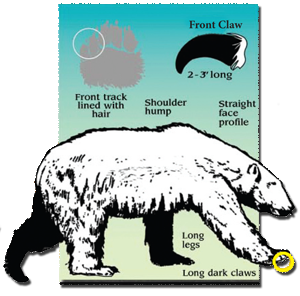
Bear Spray: Safety in the Wild
Understanding what bear pepper spray is and how to use it properly is crucial for anyone venturing into areas where bears are present.
What is bear pepper spray?
Bear pepper spray is a unique chemical formula designed specifically to deter aggressive or attacking bears. It must be registered with the Environmental Protection Agency and the Agricultural Department of each state. Bear pepper spray must contain between 1% and 2% of the active ingredients, capsaicin and related capsaicinoids.
Read the Label Carefully!
To determine if you are purchasing or selling an actual bear pepper spray, read the label carefully. The label provides information unique to and only allowed on bear pepper spray.
- Bear pepper spray will clearly display on the label identifying terms such as bear deterrent or for use in deterring attacks by bears. The word “bear” can only be used on EPA-registered bear pepper spray.
- This indicates the amount of the active ingredients, capsaicin and related capsaicinoids, which should be between 1% and 2% of the net content. These active ingredients cause reduced breathing and irritation to the eyes, nose, mouth, throat and lungs, disabling and distracting the bear from its charge.
- The minimum net content for bear pepper spray is 7.9 ounces or 225 grams.
- It identifies the owner of the EPA-registered formula.
- It identifies the actual manufacturer, the state it was manufactured in and the number indicating the order of registration.
Bear experts, outfitters and guides recommend these performance standards for bear pepper spray:
- Spray Distance: a minimum of 25 feet in order to give the bear the opportunity to stop or divert its charge.
- Canister Spray Duration: a minimum of 6 seconds, or carry two cans in case you are charged by more than one bear, have more than one incident or want to compensate for wind.
- Spray is discharged in an expanding cloud.
- Spray toward the bears face, which will be close to the ground when charging.
- A minimum net content of 7.9 oz or 225 grams.

Guidelines for Wildlife Observation and Photography
Animals that live in our forests, parks and refuges are wild. Even though they may look or act tame, they are not. Always remain 100 yards away from bears and 25 yards from other large animals.
The consequences of approaching wildlife can be serious. You are responsible for your own safety as well as the safety of wildlife. Wild animals should be allowed to forage for food, care for their young, sleep and play without human disturbance.
Animals, especially bears, need space just like you and me. Learning to enjoy wildlife safely and responsibly will help ensure that wildlife thrives for years to come. Enjoy your travels while visiting our forests, parks, and refuges. Remember, it’s our responsibility to keep wildlife wild.
Animals approached too closely may:
- Run into traffic and get hit by vehicles.
- Lose footing on cliffs and fall.
- Be separated from their young or forced to abandon their nests or dens.
- Become more vulnerable to predators because they are distracted by people or acquire a human scent.
- Abandon a food source, reducing their chances of survival.
Etiquette for Viewing and Photographing Wildlife:
- Remain alert to potential danger while viewing or taking pictures.
- View and photograph from an established observation area or the trail.
- Use binoculars, spotting scopes and telephoto lenses to view and photograph wild animals.
- Allow other visitors to enjoy wildlife; avoid blocking others’ views.
- Stay away from newborn or young animals, nests and dens.
- Never sneak up on or surprise an animal, especially a bear.
Professional photographers get great photos by:
- Using appropriate telephoto lenses.
- Photographing in controlled wildlife management areas with special access permits.
- Being patient, practicing low-impact photography, and devoting years to getting desired photos.
- Using captive and conditioned animals at zoos and game farms.
- Cropping their photographs.
Embrace the beauty of wildlife responsibly. Remember, your actions can have a lasting impact on these creatures and their habitats. Visit our sanctuary to practice safe wildlife viewing and photography.
Responding to Bears: Do's and Don'ts
When encountering a bear, it's crucial to know the right actions to take, whether you are at a distance or in close proximity
A bear at a distance:
If the bear does not see you, keep out of sight and detour as far as possible behind and downwind of the bear. If the bear does see you, retreat slowly, watching the actions of the bear. Regardless of the distance, never approach a bear.
A bear at close range:
Do not panic; your safety depends on remaining calm. If the bear clacks its teeth together, “woofs,” pants, growls or slaps its feet on the ground, it is warning you to back off.
- Do not run or make sudden movements.
- Back away very slowly.
- Talk quietly to the bear; do not shout.
- Group together and pick up small children.
- Leave your pack on for added protection.
- Avoid direct eye contact with the bear.
If the bear charges you:
Freeze. Stay in a group. Bears often bluff charge, then veer off or stop abruptly. Remain still, let the bear calm down and retreat. When the bear retreats, back away slowly.
If the bear is about to or does physically contact you:
- Drop to the ground.
- Lie flat with your stomach and face to the ground; clasp your hands behind your neck with your elbows firmly on the ground. Use your toes and elbows to resist attempts by the bear to roll you over.
- If the bear does roll you over, keep rolling so you land flat on your stomach again in the same position.
- Keep your pack on for added protection.
- Lie still; resistance will only provoke the bear.
- Make sure the bear is gone before moving.
When using bear pepper spray, point it at the bear, aiming slightly downward. When the bear is about 40 or 45 feet away, spray a short burst. This will create a cloud that the bear will have to pass through. If the bear continues to advance, keep spraying until the bear changes direction.
Facts about The Great Grizzly
Ever wonder what grizzly bears are really like? Follow along and read about the life of a grizzly bear. Find out how they mate, what they eat, and where they live.
- The grizzly bear is a North American brown bear. Its fur is typically brown and can appear to have white tips, which gives the bear its “grizzled” appearance and its name.
- Grizzly bears are found in only about 2 percent of their original range in the lower 48 states. They inhabit Montana, Wyoming, Idaho, and Washington. More than 1000 grizzlies are living in the greater Yellowstone area.
- Male grizzlies generally weigh between 600 and 700 pounds and occasionally over 800 pounds, while females weigh around 300 to 400 pounds. They are about four feet tall at the shoulders but can tower to an intimidating seven feet when standing upright on their hind legs.
- Despite their impressive size, grizzlies are capable of great speed. Top speed is typically 35 mph, although a brown bear in Denali Park in Alaska was clocked at 41 mph!
- The grizzly’s life span is approximately 20 to 25 years in the wild and 35 to 40 years in captivity.
- Grizzlies have a prominent hump between their shoulders and long claws. Both are adaptations that are related to feeding. The musculature and bone structure of the hump are adaptations for digging and for attaining the quick bursts of speed necessary to capture prey such as elk, moose, or bison.
- A grizzly’s sense of smell is seven times more powerful than a bloodhound’s. Grizzlies rely on a keen sense of smell to track their prey, and under the right conditions, they may be able to detect odors from miles away. Grizzlies may use their highly developed sense of smell to sniff out burrows of rodents and use their long claws and muscle humps to excavate their prey.
- Grizzlies are not true hibernators. True hibernators are animals whose body temperature drops to a few degrees above freezing and, when disturbed, can take over an hour to wake up. A grizzly’s hibernation is more closely related to a long rest, and the bear can wake up quickly if disturbed. During hibernation, the grizzly’s body temperature, normally 98.5 to 99 degrees, drops about 10 degrees to about 89 or 90 degrees.
- A grizzly has a four-chambered heart, just like a human. Its heartbeat is normally 40 to 70 beats per minute, but during hibernation, its heartbeat slows to 10 to 8 beats per minute.
- Grizzlies hibernate, or sleep, about six months a year. Females hibernate longer than males, especially if they have given birth to cubs.
- Grizzlies generally dig their own dens for hibernation and make beds out of dry vegetation. Burrows are often located on mountain slopes where deep snow may serve as insulation until spring. Grizzlies often dig under large stones or in the roots of mature trees. Bears may return to the same den areas year after year.
- Grizzlies become sexually mature between four and five years of age. Mating of brown bears occurs from May to July and females may copulate with several males during estrus, which lasts 10 to 30 days. Fertilized eggs develop to the blastocyst stage but do not implant until November, when the female has begun hibernating. A six- to eight-week gestation follows, and births occur from January to February, usually while the female is still in hibernation. The total gestation time ranges from 180 to 266 days.
- The number of cubs born to a female ranges from one to three and rarely four. Food supply, climate, and genetics are important in determining the number of offspring in a litter. Cubs are hairless, blind and toothless when born and weigh from less than a pound. As soon as they are born, they begin nursing on their mother’s high-fat, nutrient-rich milk while the mother continues to hibernate.
- Cubs develop rapidly on this rich diet and weigh 10 to 15 pounds on average when the family group emerges from the den in the spring.
- Cubs normally stay with the mother for two and a half to three years and remain dependent on their mother’s milk for almost a year. The mother and cubs will remain in the den together for the next two years.
- The mother, who guards the cubs and teaches them feeding techniques and how to deal with danger, is largely responsible for their survival.
- Male grizzlies do not contribute to the care of the young.
- At two to three years old, mothers drive off subadults. At this time, the adult female prepares to mate again. Subadults often spend their first year of independence with siblings, offering one another security during a vulnerable time of life.
- When cubs leave their mother permanently, males establish ranges far away from home, while females settle more closely to their mother. Only about half of the weaned Yellowstone grizzlies survive to adulthood.
- Grizzlies are omnivores; at the top of the food chain, they are predators; however, 80 to 90 percent of their diet consists of green vegetation, wild fruits and berries, nuts, bulbs and roots. They also eat animals, from insects to rodents to elk, bison, moose, bighorn, sheep, deer, pronghorn and mountain goats. Grizzlies, especially like newborn elk calves.
- The army cutworm moth is important in the diet of the grizzly bear. During peak periods when moths are abundant, bears can eat approximately 40,000 moths/day. Army cutworm moths have a nutritional value of approximately 72 percent fat, 28 percent protein and less than 1 percent carbohydrate.
- The grizzly bear will eat approximately 20,000 calories a day. The ability to eat huge quantities of rich food and store fat without suffering from heart disease and associated cholesterol problems is of great interest to researchers. Studying the grizzly heart may unlock secrets that will help humans recover from or prevent heart disease.
- Climactic fluctuations and environmental changes cause the grizzly diet to change each year to adapt to new circumstances.
Intrigued by the complex world of the grizzly bear? Contact us to learn more and discover how you can contribute to their conservation and understanding. Your curiosity fuels our mission to protect these majestic animals.
